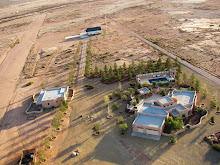The dolly zoom or the "Hitchcock zoom" is a camera technique developed by Irmin Roberts, a second unit cameraman at Paramount and is used in a variety of television and movie productions. Perhaps best know from Alfred Htichcocks film Vertigo, there are a number of other notable examples in more recent productions. Shown in this clip from Vertigo (starting at 2:04) the dolly zoom is an effect used to heighten tension in scene by inducing a feeling of "falling-away-from-oneself" or creating a feeling of unreality by distorting the perspective of the viewer. A more technically correct description of the technique is zoom in/dolly out or forward zoom/reverse track. But this description may be reversed and used as zoom out/dolly in or reverse zoom/forward track. This reversed application of the dolly zoom technique is applicable to trike videos and may be used to highlight a particular view while in flight.
The idea is that in a scene with a clearly defined foreground, midground, and background the foregroun/midground is held constant while the background moves away from the viewer. As originally concieved this technique requires a ground based camera on a dolly and the zoom adjusted as the camera moves in or out to create the effect. With an aircraft mounted video camera forward motion is a constant and it is difficult to correctly manipulate the zoom while piloting the aircraft, so it falls to post production processing to create the effect. In post production it is a simple matter to ramp the zoom (in or out) at a rate that holds the foreground/midground stable while allowing the background to fall away.
The video at this link, and shown below, shows 3 examples of the dolly zoom effect using an aircraft mounted video. The 3 examples start at 1:07 (flying through saddle), 1:29 (flying through a rock outcrop), and 2:05 (runway view upon landing). This is an anaglyph video (3D video requiring glasses with the red lens on the left, green on right) and without glasses there is somewhat more distortion, but the effect is still obvious.
In the first example the bottom edge of the foreground holds while the background falls away as the aircraft passes through the saddle. In the second example the foreground again holds while the background as viewed through the outcrop falls away from the viewer. In final example the zoom is moved in and then out which shortens then lengthens the view of the runway while landing.
Distorting the perspective of the viewer is just one more tool the flying videographer may use to impart their feelings while piloting a trike.
Subscribe to:
Post Comments (Atom)








This gave me an idea to seek for a service of aerial photographer on my wedding day. Great stuff
ReplyDelete